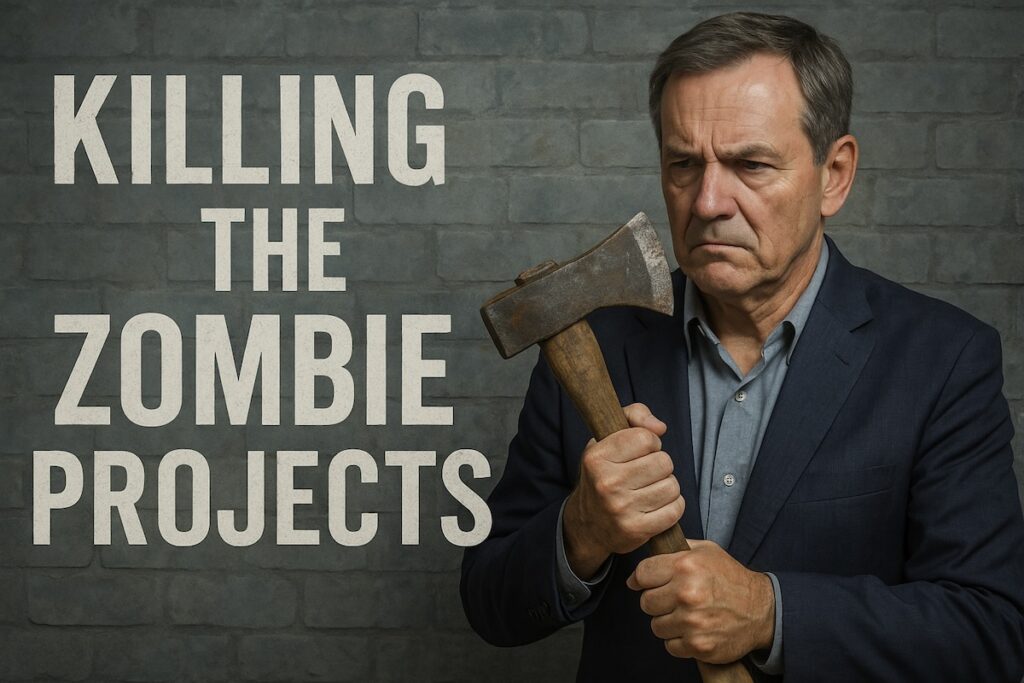Every PMO I’ve ever run has had to deal with them. They don’t moan, they don’t bite, but they will quietly eat your budget alive. I’m talking about zombie projects—initiatives that shuffle along, never really dying, never really delivering, but consuming resources as if they were headed for glory.
They show up on portfolio reports with vague percent-complete numbers, just enough activity to avoid outright cancellation, and sponsors who “still believe in the vision” even though the business case flatlined months ago.
If your PMO doesn’t have a plan to spot and stop these undead efforts, they’ll drain your capacity, kill your credibility, and keep you from delivering real value.
Here’s how to hunt them down.
1. Spot the Signs of the Undead
Zombie projects rarely declare themselves. You have to learn their tells:
- Endless “almost done” status – They’ve been 80% complete for six months.
- Shifting scope without a clear end state – No one can articulate what “done” actually looks like anymore.
- No visible business impact – Even if the deliverables were finished today, the value proposition would be unclear.
- Sponsor absenteeism – The executive who championed it is too busy to attend steering meetings.
- Resource drift – Team members keep getting pulled onto other work because “this isn’t urgent right now.”
If three or more of these are true, you’re looking at a potential zombie.
2. Demand a Current, Real Business Case
The quickest way to expose a zombie project is to ask a simple question: If we started this today, would we still do it?
Many PMOs don’t revisit business cases once a project is approved. That’s a mistake. Markets shift, strategies change, competitors move faster than expected. A project that made sense last year might be irrelevant now.
Revalidating the business case forces sponsors to confront reality. If the answer is “No, but we’ve already invested so much…”—congratulations, you’ve just met a zombie.
3. Link Funding to Measurable Value
One reason zombies thrive is that they have guaranteed funding for the year. Money flows in whether or not value flows out.
Modern PMOs break that pattern by linking continued funding to clear, measurable outcomes. If those outcomes aren’t being hit, the project goes back to the portfolio for re-approval—or it gets shut down.
It’s not personal, it’s portfolio management.
4. Build the Courage to Recommend Termination
Let’s be honest—killing a zombie project takes political backbone. No PMO leader wants to be the one to tell a senior sponsor their “priority initiative” is a waste of resources.
But here’s the truth: protecting the portfolio’s health is part of the PMO’s job. Every hour and dollar sunk into a zombie is an hour and dollar not invested in work that could deliver real value.
When you frame it that way, you’re not killing a sponsor’s pet project—you’re safeguarding the organization’s strategic execution.
5. Give Teams a Clean Exit
When you do pull the plug, don’t just walk away. Close it down professionally:
- Archive any useful assets.
- Document lessons learned (especially on how it became a zombie).
- Reassign team members quickly to meaningful work so morale doesn’t take a hit.
Ending a project doesn’t have to feel like failure—it can be framed as a smart decision that frees capacity for higher-impact initiatives.
Final Word from the Trenches
Zombie projects are portfolio parasites. They survive on the goodwill of sponsors, the reluctance to “waste sunk costs,” and the absence of rigorous benefit tracking.
The PMO’s job isn’t just to start projects—it’s to ensure that every active initiative is moving the organization toward its strategic goals. That means having the guts to pull the trigger when a project no longer justifies its existence.
I’ve killed more than a few in my time. You’ll get some pushback. You might even get labeled “the executioner.” But here’s the thing—when the dust settles, and you’ve freed up resources for something that actually matters, those same people will thank you.
And if they don’t? Well, at least you’ve kept the undead from overrunning your portfolio.




